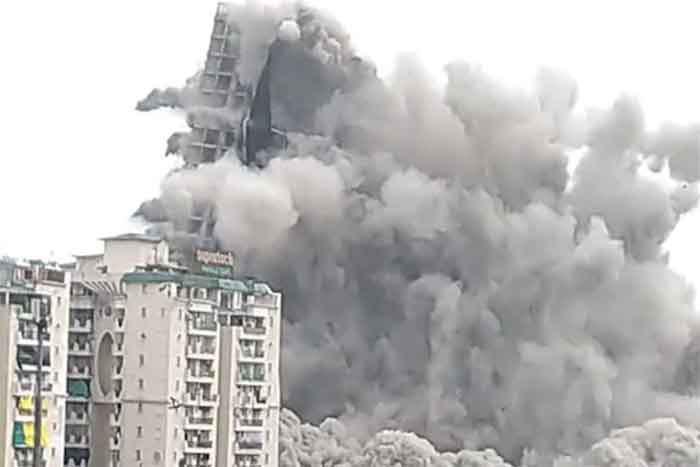
On August 28, 3700 kg. of explosives were used in Noida city ( in national capital region) to demolish two 100-metre tall structures called Apex ( 32 storeys) and Ceyane ( 29 storeys), following court orders based on complaints of glaring violations of construction regulations and the builder’s own earlier commitments.
These twin towers were not in the original plans of development and were built on what should have been kept as green area for residents. The residents were therefore well justified in going to court for justice and court orders have been praised by many for sending a clear signal that such violations and corrupt practices will not be tolerated. However a question arises—as the violations of building regulations are not at all so rare in India, will such drastic actions be repeated? Can we not find less destructive ways of punishing violators of regulations?
If following the first news or complaints of violations, the twin towers had been stopped before work on them was started, then a great saving of heavy economic and ecological loss would have been possible. If this was not possible but work could be stopped at a relatively early stage, then also substantial ecological and economic costs could have been avoided. The first was the most desirable option and the second was the next desirable option.
Now let us consider the third, and the actual situation, in which the twin tower construction has been more or less completed. Now here the important question to ask is– while violations relating to green areas and overbuilding are of course there, what is the situation regarding structural safety. If the building is found to be structurally unsafe with the risk of collapsing and if this situation cannot be remedied by any repair work, then the solution of a controlled demolition, as ordered and implemented, is the right one. However if the building is found to be structurally safe, then the court could shift its ownership from the builder to the government or a public interest organization. The new owner could then use its substantial assets to purchase land in the vicinity and planting a beautiful garden here, make it available to those residents who were deprived of their green area in the first place. All those who had deposited money to purchase flats would have got their flats as well. At the same time the massive dust pollution, the around 80,000 tonnes of debris, the bird life endangered, the costs to human health could have been avoided. While immediate reports suggest neighboring buildings are quite safe, we cannot be equally sure that longer term adverse impacts will not be revealed later. All these could have been easily avoided and much could have been saved.
This, moreover, is just one of several possible creative solutions, keeping in view the objective of avoiding any destruction to national wealth to the extent possible, and saving national wealth to the extent possible.
It is important to discuss these alternative ways of tackling such a situation as violations of building regulations are quite common and if we search wide enough then even more serious violations than what took place in the context of twin towers can be found. So it is important to find those ways of dealing with such violations which do not involve any destruction of national wealth as well as of environment. This will help us to come up with more creative and less destructive solutions whenever any serious cases of violations of building regulations are reported in future.
This writer had suggested a similar creative solution when orders were given to demolish many huts and small houses in a case which allegedly involved encroachment of green area by workers and mostly very poor people. What I had suggested was– let the huts and small houses remain but ask all the occupants to devote on average one day of volunteer work (shramdan) of one adult member per household per week for planting trees and maintaining them in a big area near their colony. Thus the objective of increasing the green area would have been achieved without displacing anyone, while at the same time providing more green and healthy living conditions to hut dwellers and other residents of the area.
Bharat Dogra is Honorary Convener, Campaign to Save Earth Now. His recent books include A Day in 2071, Planet in Peril and Man over Machine.










































